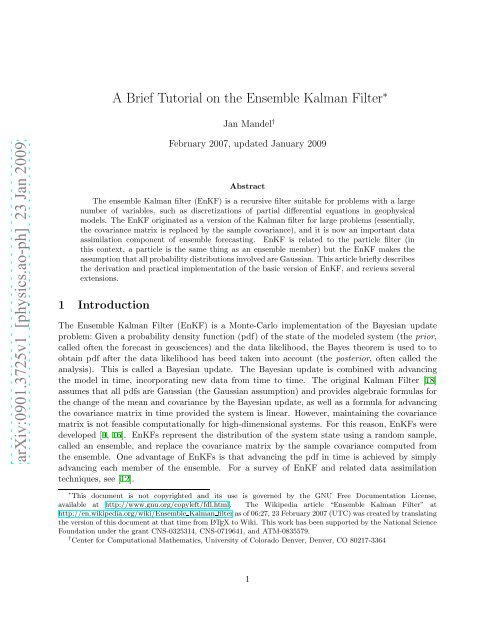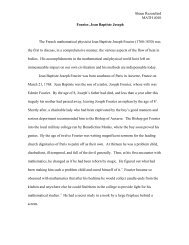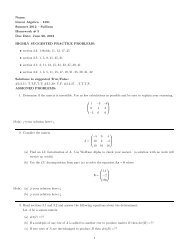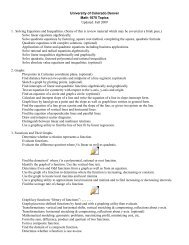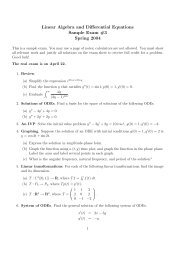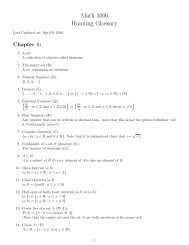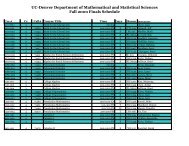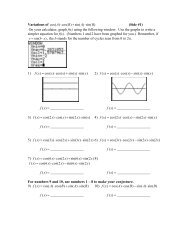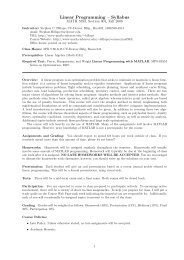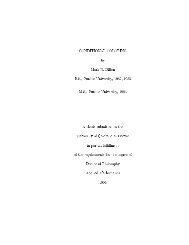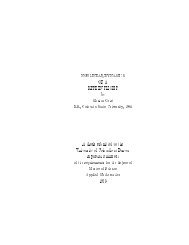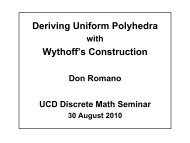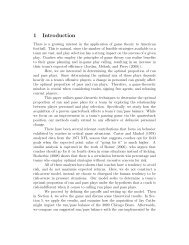A Brief Tutorial on the Ensemble Kalman Filter
A Brief Tutorial on the Ensemble Kalman Filter
A Brief Tutorial on the Ensemble Kalman Filter
You also want an ePaper? Increase the reach of your titles
YUMPU automatically turns print PDFs into web optimized ePapers that Google loves.
arXiv:0901.3725v1 [physics.ao-ph] 23 Jan 2009<br />
A <str<strong>on</strong>g>Brief</str<strong>on</strong>g> <str<strong>on</strong>g>Tutorial</str<strong>on</strong>g> <strong>on</strong> <strong>the</strong> <strong>Ensemble</strong> <strong>Kalman</strong> <strong>Filter</strong> ∗<br />
Jan Mandel †<br />
February 2007, updated January 2009<br />
Abstract<br />
The ensemble <strong>Kalman</strong> filter (EnKF) is a recursive filter suitable for problems with a large<br />
number of variables, such as discretizati<strong>on</strong>s of partial differential equati<strong>on</strong>s in geophysical<br />
models. The EnKF originated as a versi<strong>on</strong> of <strong>the</strong> <strong>Kalman</strong> filter for large problems (essentially,<br />
<strong>the</strong> covariance matrix is replaced by <strong>the</strong> sample covariance), and it is now an important data<br />
assimilati<strong>on</strong> comp<strong>on</strong>ent of ensemble forecasting. EnKF is related to <strong>the</strong> particle filter (in<br />
this c<strong>on</strong>text, a particle is <strong>the</strong> same thing as an ensemble member) but <strong>the</strong> EnKF makes <strong>the</strong><br />
assumpti<strong>on</strong> that all probability distributi<strong>on</strong>s involved are Gaussian. This article briefly describes<br />
<strong>the</strong> derivati<strong>on</strong> and practical implementati<strong>on</strong> of <strong>the</strong> basic versi<strong>on</strong> of EnKF, and reviews several<br />
extensi<strong>on</strong>s.<br />
1 Introducti<strong>on</strong><br />
The <strong>Ensemble</strong> <strong>Kalman</strong> <strong>Filter</strong> (EnKF) is a M<strong>on</strong>te-Carlo implementati<strong>on</strong> of <strong>the</strong> Bayesian update<br />
problem: Given a probability density functi<strong>on</strong> (pdf) of <strong>the</strong> state of <strong>the</strong> modeled system (<strong>the</strong> prior,<br />
called often <strong>the</strong> forecast in geosciences) and <strong>the</strong> data likelihood, <strong>the</strong> Bayes <strong>the</strong>orem is used to to<br />
obtain pdf after <strong>the</strong> data likelihood has beed taken into account (<strong>the</strong> posterior, often called <strong>the</strong><br />
analysis). This is called a Bayesian update. The Bayesian update is combined with advancing<br />
<strong>the</strong> model in time, incorporating new data from time to time. The original <strong>Kalman</strong> <strong>Filter</strong> [18]<br />
assumes that all pdfs are Gaussian (<strong>the</strong> Gaussian assumpti<strong>on</strong>) and provides algebraic formulas for<br />
<strong>the</strong> change of <strong>the</strong> mean and covariance by <strong>the</strong> Bayesian update, as well as a formula for advancing<br />
<strong>the</strong> covariance matrix in time provided <strong>the</strong> system is linear. However, maintaining <strong>the</strong> covariance<br />
matrix is not feasible computati<strong>on</strong>ally for high-dimensi<strong>on</strong>al systems. For this reas<strong>on</strong>, EnKFs were<br />
developed [9, 16]. EnKFs represent <strong>the</strong> distributi<strong>on</strong> of <strong>the</strong> system state using a random sample,<br />
called an ensemble, and replace <strong>the</strong> covariance matrix by <strong>the</strong> sample covariance computed from<br />
<strong>the</strong> ensemble. One advantage of EnKFs is that advancing <strong>the</strong> pdf in time is achieved by simply<br />
advancing each member of <strong>the</strong> ensemble. For a survey of EnKF and related data assimilati<strong>on</strong><br />
techniques, see [12].<br />
∗ This document is not copyrighted and its use is governed by <strong>the</strong> GNU Free Documentati<strong>on</strong> License,<br />
available at http://www.gnu.org/copyleft/fdl.html. The Wikipedia article “<strong>Ensemble</strong> <strong>Kalman</strong> <strong>Filter</strong>” at<br />
http://en.wikipedia.org/wiki/<strong>Ensemble</strong> <strong>Kalman</strong> filter as of 06:27, 23 February 2007 (UTC) was created by translating<br />
<strong>the</strong> versi<strong>on</strong> of this document at that time from L ATEX to Wiki. This work has been supported by <strong>the</strong> Nati<strong>on</strong>al Science<br />
Foundati<strong>on</strong> under <strong>the</strong> grant CNS-0325314, CNS-0719641, and ATM-0835579.<br />
† Center for Computati<strong>on</strong>al Ma<strong>the</strong>matics, University of Colorado Denver, Denver, CO 80217-3364<br />
1
2 A derivati<strong>on</strong> of <strong>the</strong> EnKF<br />
2.1 The <strong>Kalman</strong> <strong>Filter</strong><br />
Let us review first <strong>the</strong> <strong>Kalman</strong> filter. Let x denote <strong>the</strong> n-dimensi<strong>on</strong>al state vector of a model, and<br />
assume that it has Gaussian probability distributi<strong>on</strong> with mean µ and covariance Q, i.e., its pdf is<br />
<br />
p(x) ∝ exp − 1<br />
2 (x − µ)TQ −1 <br />
(x − µ) .<br />
Here and below, ∝ means proporti<strong>on</strong>al; a pdf is always scaled so that its integral over <strong>the</strong> whole<br />
space is <strong>on</strong>e. This probability distributi<strong>on</strong>, called <strong>the</strong> prior, was evolved in time by running <strong>the</strong><br />
model and now is to be updated to account for new data. It is natural to assume that <strong>the</strong> error<br />
distributi<strong>on</strong> of <strong>the</strong> data is known; data have to come with an error estimate, o<strong>the</strong>rwise <strong>the</strong>y are<br />
meaningless. Here, <strong>the</strong> data d is assumed to have Gaussian pdf with covariance R and mean Hx,<br />
where H is <strong>the</strong> so-called <strong>the</strong> observati<strong>on</strong> matrix. The covariance matrix R describes <strong>the</strong> estimate<br />
of <strong>the</strong> error of <strong>the</strong> data; if <strong>the</strong> random errors in <strong>the</strong> entries of <strong>the</strong> data vector d are independent, R<br />
is diag<strong>on</strong>al and its diag<strong>on</strong>al entries are <strong>the</strong> squares of <strong>the</strong> standard deviati<strong>on</strong> (“error size”) of <strong>the</strong><br />
error of <strong>the</strong> corresp<strong>on</strong>ding entries of <strong>the</strong> data vector d. The value Hx is what <strong>the</strong> value of <strong>the</strong> data<br />
would be for <strong>the</strong> state x in <strong>the</strong> absence of data errors. Then <strong>the</strong> probability density p(d|x) of <strong>the</strong><br />
<strong>the</strong> data d c<strong>on</strong>diti<strong>on</strong>al of <strong>the</strong> system state x, called <strong>the</strong> data likelihood, is<br />
<br />
p (d|x) ∝ exp − 1<br />
2 (d − Hx)TR −1 <br />
(d − Hx) .<br />
The pdf of <strong>the</strong> state and <strong>the</strong> data likelihood are combined to give <strong>the</strong> new probability density<br />
of <strong>the</strong> system state x c<strong>on</strong>diti<strong>on</strong>al <strong>on</strong> <strong>the</strong> value of <strong>the</strong> data d (<strong>the</strong> posterior) by <strong>the</strong> Bayes <strong>the</strong>orem,<br />
p (x|d) ∝ p (d|x) p(x).<br />
The data d is fixed <strong>on</strong>ce it is received, so denote <strong>the</strong> posterior state by ˆx instead of x|d and <strong>the</strong><br />
posterior pdf by p (ˆx). It can be shown by algebraic manipulati<strong>on</strong>s [1] that <strong>the</strong> posterior pdf is also<br />
Gaussian,<br />
<br />
p (ˆx) ∝ exp − 1<br />
2 (ˆx − ˆµ)T <br />
Qˆ −1<br />
(ˆx − ˆµ) ,<br />
with <strong>the</strong> posterior mean ˆµ and covariance ˆ Q given by <strong>the</strong> <strong>Kalman</strong> update formulas<br />
where<br />
is <strong>the</strong> so-called <strong>Kalman</strong> gain matrix.<br />
2.2 The <strong>Ensemble</strong> <strong>Kalman</strong> <strong>Filter</strong><br />
ˆµ = µ + K (d − Hµ) , ˆ Q = (I − KH)Q,<br />
K = QH T HQH T + R −1<br />
The EnKF is a M<strong>on</strong>te Carlo approximati<strong>on</strong> of <strong>the</strong> <strong>Kalman</strong> filter, which avoids evolving <strong>the</strong><br />
covariance matrix of <strong>the</strong> pdf of <strong>the</strong> state vector x. Instead, <strong>the</strong> distributi<strong>on</strong> is represented by<br />
a collecti<strong>on</strong> of realizati<strong>on</strong>s, called an ensemble. So, let<br />
X = [x1,... ,xN] = [xi]<br />
2
e an n × N matrix whose columns are a sample from <strong>the</strong> prior distributi<strong>on</strong>. The matrix X is<br />
called <strong>the</strong> prior ensemble. Replicate <strong>the</strong> data d into an m × N matrix<br />
D = [d1,...,dN] = [di]<br />
so that each column di c<strong>on</strong>sists of <strong>the</strong> data vector d plus a random vector from <strong>the</strong> n-dimensi<strong>on</strong>al<br />
normal distributi<strong>on</strong> N(0,R). Then <strong>the</strong> columns of<br />
ˆX = X + K(D − HX)<br />
form a random sample from <strong>the</strong> posterior distributi<strong>on</strong>. The EnKF is now obtained [17] simply by<br />
replacing <strong>the</strong> state covariance Q in <strong>Kalman</strong> gain matrix K = QH T HQH T + R −1 by <strong>the</strong> sample<br />
covariance C computed from <strong>the</strong> ensemble members (called <strong>the</strong> ensemble covariance).<br />
3 Theoretical analysis<br />
It is comm<strong>on</strong>ly stated that <strong>the</strong> ensemble is a sample (that is, independent identically distributed<br />
random variables, i.i.d.) and its probability distributi<strong>on</strong> is represented by <strong>the</strong> mean and covariance,<br />
thus assuming that <strong>the</strong> ensemble is normally distributed. Although <strong>the</strong> resulting analyses, e.g., [7],<br />
played an important role in <strong>the</strong> development of EnKF, both statements are false. The ensemble<br />
covariance is computed from all ensemble members toge<strong>the</strong>r, which introduces dependence, and<br />
<strong>the</strong> EnKF formula is a n<strong>on</strong>linear functi<strong>on</strong> of <strong>the</strong> ensemble, which destroys <strong>the</strong> normality of <strong>the</strong><br />
ensemble distributi<strong>on</strong>. For a ma<strong>the</strong>matical proof of <strong>the</strong> c<strong>on</strong>vergence of <strong>the</strong> EnKF in <strong>the</strong> limit for<br />
large ensembles to <strong>the</strong> <strong>Kalman</strong> filer, see [23]. The core of <strong>the</strong> analysis is a proof that large ensembles<br />
in <strong>the</strong> EnKF are, in fact, nearly i.i.d. and nearly normal.<br />
4 Implementati<strong>on</strong><br />
4.1 Basic formulati<strong>on</strong><br />
Here we follow [7, 10, 19]. Suppose <strong>the</strong> ensemble matrix X and <strong>the</strong> data matrix D are as above.<br />
The ensemble mean and <strong>the</strong> covariance are<br />
E (X) = 1<br />
N<br />
N<br />
k=1<br />
xk, C = AAT<br />
N − 1 ,<br />
where<br />
A = X − E (X) = X − 1<br />
N (XeN×1)e1×N,<br />
and e denotes <strong>the</strong> matrix of all <strong>on</strong>es of <strong>the</strong> indicated size.<br />
The posterior ensemble Xp is <strong>the</strong>n given by<br />
ˆX ≈ X p = X + CH T HCH T + R −1 (D − HX),<br />
where <strong>the</strong> perturbed data matrix D is as above. It can be shown that <strong>the</strong> posterior ensemble<br />
c<strong>on</strong>sists of linear combinati<strong>on</strong>s of members of <strong>the</strong> prior ensemble.<br />
3
Note that since R is a covariance matrix, it is always positive semidefinite and usually<br />
positive definite, so <strong>the</strong> inverse above exists and <strong>the</strong> formula can be implemented by <strong>the</strong> Choleski<br />
decompositi<strong>on</strong> [19]. In [7, 10], R is replaced by <strong>the</strong> sample covariance DD T /(N − 1) and <strong>the</strong> inverse<br />
is replaced by a pseudoinverse, computed using <strong>the</strong> Singular Values Decompositi<strong>on</strong> (SVD).<br />
Since <strong>the</strong>se formulas are matrix operati<strong>on</strong>s with dominant Level 3 operati<strong>on</strong>s [14], <strong>the</strong>y are<br />
suitable for efficient implementati<strong>on</strong> using software packages such as LAPACK (<strong>on</strong> serial and<br />
shared memory computers) and ScaLAPACK (<strong>on</strong> distributed memory computers) [19]. Instead<br />
of computing <strong>the</strong> inverse of a matrix and multiplying by it, it is much better (several times<br />
cheaper and also more accurate) to compute <strong>the</strong> Choleski decompositi<strong>on</strong> of <strong>the</strong> matrix and treat<br />
<strong>the</strong> multiplicati<strong>on</strong> by <strong>the</strong> inverse as soluti<strong>on</strong> of a linear system with many simultaneous right-hand<br />
sides [14].<br />
4.2 Observati<strong>on</strong> matrix-free implementati<strong>on</strong><br />
It is usually inc<strong>on</strong>venient to c<strong>on</strong>struct and operate with <strong>the</strong> matrix H explicitly; instead, a functi<strong>on</strong><br />
h(x) of <strong>the</strong> form<br />
h(x) = Hx, (1)<br />
is more natural to compute. The functi<strong>on</strong> h is called <strong>the</strong> observati<strong>on</strong> functi<strong>on</strong> or, in <strong>the</strong> inverse<br />
problems c<strong>on</strong>text, <strong>the</strong> forward operator. The value of h(x) is what <strong>the</strong> value of <strong>the</strong> data would be<br />
for <strong>the</strong> state x assuming <strong>the</strong> measurement is exact. Then [19, 22] <strong>the</strong> posterior ensemble can be<br />
rewritten as<br />
X p = X + 1<br />
N − 1 A(HA)T P −1 (D − HX)<br />
where<br />
and<br />
with<br />
HA = HX − 1<br />
N ((HX)eN×1)e1×N,<br />
P = 1<br />
N − 1 HA(HA)T + R,<br />
[HA] i = Hxi − H 1<br />
N<br />
= h(xi) − 1<br />
N<br />
N<br />
j=1<br />
xj<br />
N<br />
h(xj).<br />
C<strong>on</strong>sequently, <strong>the</strong> ensemble update can be computed by evaluating <strong>the</strong> observati<strong>on</strong> functi<strong>on</strong> h <strong>on</strong><br />
each ensemble member <strong>on</strong>ce and <strong>the</strong> matrix H does not need to be known explicitly. This formula<br />
also holds [19] for an observati<strong>on</strong> functi<strong>on</strong> h(x) = Hx + f with a fixed offset f, which also does<br />
not need to be known explicitly. The above formula has been comm<strong>on</strong>ly used for a n<strong>on</strong>linear<br />
observati<strong>on</strong> functi<strong>on</strong> h, such as <strong>the</strong> positi<strong>on</strong> of a hurricane vortex [8]. In that case, <strong>the</strong> observati<strong>on</strong><br />
functi<strong>on</strong> is essentially approximated by a linear functi<strong>on</strong> from its values at <strong>the</strong> ensemble members.<br />
4<br />
j=1
4.3 Implementati<strong>on</strong> for a large number of data points<br />
For a large number m of data points, <strong>the</strong> multiplicati<strong>on</strong> by P −1 becomes a bottleneck. The following<br />
alternative formula [19, 22] is advantageous when <strong>the</strong> number of data points m is large (such as<br />
when assimilating gridded or pixel data) and <strong>the</strong> data error covariance matrix R is diag<strong>on</strong>al (which<br />
is <strong>the</strong> case when <strong>the</strong> data errors are uncorrelated), or cheap to decompose (such as banded due to<br />
limited covariance distance). Using <strong>the</strong> Sherman-Morris<strong>on</strong>-Woodbury formula [15]<br />
with<br />
gives<br />
P −1 =<br />
(R + UV T ) −1 = R −1 − R −1 U(I + V T R −1 U) −1 V T R −1 ,<br />
<br />
R + 1<br />
N − 1 HA(HA)T<br />
= R −1<br />
<br />
I − 1<br />
N − 1 (HA)<br />
U = 1<br />
HA, V = HA,<br />
N − 1<br />
<br />
−1<br />
I + (HA) T R −1<br />
1<br />
N − 1 (HA)<br />
−1 (HA) T R −1<br />
which requires <strong>on</strong>ly <strong>the</strong> soluti<strong>on</strong> of systems with <strong>the</strong> matrix R (assumed to be cheap) and of a<br />
system of size N with m right-hand sides. See [19] for operati<strong>on</strong> counts.<br />
5 Fur<strong>the</strong>r extensi<strong>on</strong>s<br />
The EnKF versi<strong>on</strong> described here involves randomizati<strong>on</strong> of data. For filters without randomizati<strong>on</strong><br />
of data, see [2, 11, 25].<br />
Since <strong>the</strong> ensemble covariance is rank-deficient (<strong>the</strong>re are many more state variables, typically<br />
milli<strong>on</strong>s, than <strong>the</strong> ensemble members, typically less than a hundred), it has large terms for pairs of<br />
points that are spatially distant. Since in reality <strong>the</strong> values of physical fields at distant locati<strong>on</strong>s<br />
are not that much correlated, <strong>the</strong> covariance matrix is tapered off artificially based <strong>on</strong> <strong>the</strong> distance,<br />
which results in better approximati<strong>on</strong> of <strong>the</strong> covariance for small ensembles [13], such as typically<br />
used in practice. Fur<strong>the</strong>r development of this idea gives rise to localized EnKF algorithms [3, 24].<br />
For problems with coherent features, such as firelines, squall lines, and rain fr<strong>on</strong>ts, <strong>the</strong>re is a need<br />
to adjust <strong>the</strong> simulati<strong>on</strong> state by distorting <strong>the</strong> state in space as well as by an additive correcti<strong>on</strong><br />
to <strong>the</strong> state. The morphing EnKF [5, 20] employs intermediate states, obtained by techniques<br />
borrowed from image registrati<strong>on</strong> and morphing, instead of linear combinati<strong>on</strong>s of states.<br />
EnKFs rely <strong>on</strong> <strong>the</strong> Gaussian assumpti<strong>on</strong>, though <strong>the</strong>y are of course used in practice for n<strong>on</strong>linear<br />
problems, where <strong>the</strong> Gaussian assumpti<strong>on</strong> is not satisfied. Related filters attempting to relax <strong>the</strong><br />
Gaussian assumpti<strong>on</strong> in EnKF while preserving its advantages include filters that fit <strong>the</strong> state pdf<br />
with multiple Gaussian kernels [4], filters that approximate <strong>the</strong> state pdf by Gaussian mixtures [6],<br />
a variant of <strong>the</strong> particle filter with computati<strong>on</strong> of particle weights by density estimati<strong>on</strong> [20, 21],<br />
and a variant of <strong>the</strong> particle filter with thick tailed pdfs to alleviate particle filter degeneracy [26].<br />
5<br />
<br />
,
References<br />
[1] B. D. O. Anders<strong>on</strong> and J. B. Moore, Optimal filtering, Prentice-Hall, Englewood Cliffs,<br />
N.J., 1979.<br />
[2] J. L. Anders<strong>on</strong>, An ensemble adjustment <strong>Kalman</strong> filter for data assimilati<strong>on</strong>, M<strong>on</strong>thly<br />
Wea<strong>the</strong>r Review, 129 (1999), pp. 2884–2903.<br />
[3] , A local least squares framework for ensemble filtering, M<strong>on</strong>thly Wea<strong>the</strong>r Review, 131<br />
(2003), pp. 634–642.<br />
[4] J. L. Anders<strong>on</strong> and S. L. Anders<strong>on</strong>, A M<strong>on</strong>te Carlo implementati<strong>on</strong> of <strong>the</strong> n<strong>on</strong>linear<br />
filtering problem to produce ensemble assimilati<strong>on</strong>s and forecasts, M<strong>on</strong>thly Wea<strong>the</strong>r Review,<br />
127 (1999), pp. 2741–2758.<br />
[5] J. D. Beezley and J. Mandel, Morphing ensemble <strong>Kalman</strong> filters, Tellus, 60A (2008),<br />
pp. 131–140.<br />
[6] T. Bengtss<strong>on</strong>, C. Snyder, and D. Nychka, Toward a n<strong>on</strong>linear ensemble filter for<br />
high dimensi<strong>on</strong>al systems, Journal of Geophysical Research - Atmospheres, 108(D24) (2003),<br />
pp. STS 2–1–10.<br />
[7] G. Burgers, P. J. van Leeuwen, and G. Evensen, Analysis scheme in <strong>the</strong> ensemble<br />
<strong>Kalman</strong> filter, M<strong>on</strong>thly Wea<strong>the</strong>r Review, 126 (1998), pp. 1719–1724.<br />
[8] Y. Chen and C. Snyder, Assimilating vortex positi<strong>on</strong> with an ensemble <strong>Kalman</strong> filter,<br />
M<strong>on</strong>thly Wea<strong>the</strong>r Review, 135 (2007), pp. 1828–1845.<br />
[9] G. Evensen, Sequential data assimilati<strong>on</strong> with n<strong>on</strong>linear quasi-geostrophic model using M<strong>on</strong>te<br />
Carlo methods to forecast error statistics, Journal of Geophysical Research, 99 (C5) (1994),<br />
pp. 143–162.<br />
[10] G. Evensen, The ensemble <strong>Kalman</strong> filter: Theoretical formulati<strong>on</strong> and practical<br />
implementati<strong>on</strong>, Ocean Dynamics, 53 (2003), pp. 343–367.<br />
[11] , Sampling strategies and square root analysis schemes for <strong>the</strong> EnKF, Ocean Dynamics,<br />
54 (2004), pp. 539–560.<br />
[12] G. Evensen, Data assimilati<strong>on</strong>: The ensemble <strong>Kalman</strong> filter, Springer, Berlin, 2007.<br />
[13] R. Furrer and T. Bengtss<strong>on</strong>, Estimati<strong>on</strong> of high-dimensi<strong>on</strong>al prior and posterior<br />
covariance matrices in <strong>Kalman</strong> filter variants, J. Multivariate Anal., 98 (2007), pp. 227–255.<br />
[14] G. H. Golub and C. F. V. Loan, Matrix Computati<strong>on</strong>s, Johns Hopkins Univ. Press, 1989.<br />
Sec<strong>on</strong>d Editi<strong>on</strong>.<br />
[15] W. W. Hager, Updating <strong>the</strong> inverse of a matrix, SIAM Rev., 31 (1989), pp. 221–239.<br />
[16] P. Houtekamer and H. L. Mitchell, Data assimilati<strong>on</strong> using an ensemble <strong>Kalman</strong> filter<br />
technique, M<strong>on</strong>thly Wea<strong>the</strong>r Review, 126 (1998), pp. 796–811.<br />
6
[17] C. J. Johns and J. Mandel, A two-stage ensemble <strong>Kalman</strong> filter for smooth data<br />
assimilati<strong>on</strong>, Envir<strong>on</strong>mental and Ecological Statistics, 15 (2008), pp. 101–110.<br />
[18] R. E. <strong>Kalman</strong>, A new approach to linear filtering and predicti<strong>on</strong> problems, Transacti<strong>on</strong>s of<br />
<strong>the</strong> ASME – Journal of Basic Engineering, Series D, 82 (1960), pp. 35–45.<br />
[19] J. Mandel, Efficient implementati<strong>on</strong> of <strong>the</strong> ensemble <strong>Kalman</strong> filter. CCM Report 231,<br />
University of Colorado Denver, 2006.<br />
[20] J. Mandel and J. D. Beezley, Predictor-corrector and morphing ensemble filters<br />
for <strong>the</strong> assimilati<strong>on</strong> of sparse data into high dimensi<strong>on</strong>al n<strong>on</strong>linear systems.<br />
CCM Report 239, University of Colorado at Denver and Health Sciences Center.<br />
http://www.math.cudenver.edu/ccm/reports/rep239.pdf, November 2006. 11th Symposium<br />
<strong>on</strong> Integrated Observing and Assimilati<strong>on</strong> Systems for <strong>the</strong> Atmosphere, Oceans, and Land<br />
Surface (IOAS-AOLS), CD-ROM, Paper 4.12, 87th American Meterological Society Annual<br />
Meeting, San Ant<strong>on</strong>io, TX, January 2007, http://www.ametsoc.org.<br />
[21] , An ensemble <strong>Kalman</strong>-particle predictor-corrector filter for n<strong>on</strong>-gaussian data<br />
assimilati<strong>on</strong>. ICCS 2009, Lecture Notes in Computer Science, Springer, to appear, 2009.<br />
arXiv:0812.2290, 2008.<br />
[22] J. Mandel, J. D. Beezley, J. L. Coen, and M. Kim, Data assimilati<strong>on</strong> for wildland fires:<br />
<strong>Ensemble</strong> <strong>Kalman</strong> filters in coupled atmosphere-surface models. arXiv:0712.3965, 2007.<br />
[23] J. Mandel, L. Cobb, and J. D. Beezley, On <strong>the</strong> c<strong>on</strong>vergence of <strong>the</strong> ensemble <strong>Kalman</strong><br />
filter. arxiv:0901.2951, 2009.<br />
[24] E. Ott, B. R. Hunt, I. Szunyogh, A. V. Zimin, E. J. Kostelich, M. Corazza,<br />
E. Kalnay, D. Patil, and J. A. Yorke, A local ensemble <strong>Kalman</strong> filter for atmospheric<br />
data assimilati<strong>on</strong>, Tellus, 56A (2004), pp. 415–428.<br />
[25] M. K. Tippett, J. L. Anders<strong>on</strong>, C. H. Bishop, T. M. Hamill, and J. S. Whitaker,<br />
<strong>Ensemble</strong> square root filters, M<strong>on</strong>thly Wea<strong>the</strong>r Review, 131 (2003), pp. 1485–1490.<br />
[26] P. van Leeuwen, A variance-minimizing filter for large-scale applicati<strong>on</strong>s, M<strong>on</strong>thly Wea<strong>the</strong>r<br />
Review, 131 (2003), pp. 2071–2084.<br />
7


